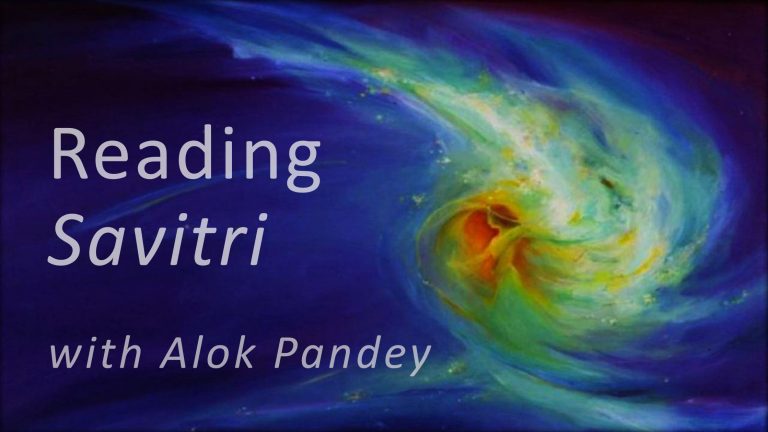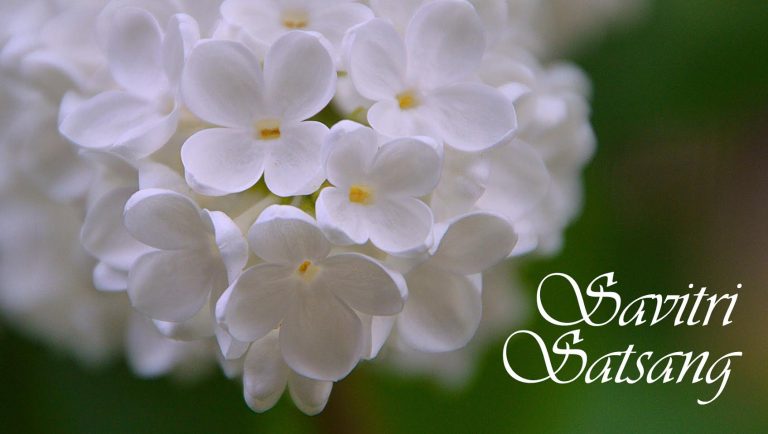The Mother was back in India, back in Pondicherry, that small town in the South-East where Sri Aurobindo had been pursuing his integral yoga-path since 1910. Her return was now final and she was never again to leave India, the country of her choice. Her relationship with Paul Richard was at this stage coming to a breaking-point since she could follow her destiny now and establish an ever closer collaboration with Sri Aurobindo. It was probably clear to Paul that the Mother was now completely giving herself to Sri Aurobindo and that there was a kind of collaboration and development in their relationship which he could not follow any more. He could recognize Sri Aurobindo as a great yogi and sage, but he did not want to become his disciple and may have tried also to draw the Mother away from him. But this effort was bound to fail and so he left Pondicherry. He kept travelling for some time in India, but later he went to America where he founded a Centre of Asian Studies.
The Mother had foreseen this development in a significant vision which Sri Aurobindo once related to a disciple: “The Mother (Mirra), Richard and I were going somewhere. We saw Richard going down to a place from which rising was impossible. Then we found ourselves sitting in a carriage the driver of which was taking it up and down a hill a number of times. At last he stopped on the highest peak. Its significance was quite clear to us.”[1]
The Mother and Miss Hodgeson were at first staying in some Guest Houses, before moving into the Bayoud House at rue St. Martin. On 24 November 1920 there was a heavy tempest in the town and a flood-like rainfall. The roof of a godown opposite the Vinayak temple had collapsed owing to the heavy rain. When Sri Aurobindo was informed that the roof of the house in which the Mother was staying was not safe either, he asked her and her English friend to move into his own house at rue Francois Martin. Since then the Mother has always been staying in the same house as Sri Aurobindo, wherever it might be. She was now doing intensive Yoga with him and the sadhana was brought down from the mental to the vital plane. As a result the Mother experienced a visible physical change: “…after a month’s yoga I looked exactly eighteen. And someone who had seen me before, who had lived with me in Japan and came here, found it difficult to recognize me. He asked me, ‘But really, is it you?’ I said, ‘Of course!’ ”[2]
A similar surprise was experienced once by Ambubhai Purani who had seen Sri Aurobindo in Pondicherry in 1918. When he came back in 1921, he noticed a clear change in Sri Aurobindo’s complexion. “What has happened to you?” he exclaimed in astonishment. Sri Aurobindo explained to him that a great transformation took place in the nervous system and even the physical system when the higher consciousness came down to the vital plane. Purani also saw the Mother now, for the first time. “She was standing near the staircase when Sri Aurobindo was going upstairs after lunch. Such unearthly beauty I had never seen – she appeared to be about 20 whereas she was more than 43 years old.”[3]
Later on, when the yoga was brought down to the physical plane, this extraordinary manifestation of youth in the Mother came to an end, since considerable obstacles had to be worked out and dealt with in the physical being which resisted transformation. But this was the proper work of Sri Aurobindo and the Mother to prepare even the physical plane, which had been hitherto neglected by the yogis, for the descent of the supreme Light. It was an extremely difficult undertaking, a struggle with the element ‘Earth’, a fight with the forces of the world.
They got a little foretaste of the upcoming difficulties during the episode of the ‘stone-throwing’, which took place by the middle of December 1921. Datta (Miss Hodgeson) had scolded a cook named Vatel for bad behaviour. Vatel wanted to take revenge for this reproof and made contact with a black-magician in the town. After some time stones suddenly started falling into the courtyard, even though no one was seen. The police were called, but they could not be of any help in the matter. Finally, when the hail of stones became too dangerous, the Mother went into deep meditation to find out the cause. She discovered three vital entities which were held under a magical charm. She sent them away and they never came back. After the magic had been broken, the black-magical force rebounded on the originator with a kind of boomerang effect. Vatel became very ill and had to be taken to hospital. When Sri Aurobindo was informed that the cook was dying, he said, “Oh! just for a few stones!”,[4] and Vatel was cured the same evening.
The Mother’s arrival in Sri Aurobindo’s house entailed several changes in the household. His disciples had so far been living rather freely and without constraints. Sri Aurobindo did not interfere much with what they were doing, since he was immersed in his own sadhana. Properly speaking, he was not yet playing the role of a guru and therefore at this stage we can only speak with reservation of ‘disciples’. The Mother became part of this community now and the whole household was newly arranged by her. Books were nicely stacked in cupboards and everything found its right place. At the same time collective meditations were begun in which Sri Aurobindo, the Mother, the members of his group as well as visitors took part. All these changes and the new discipline made some disciples revolt and grumble, but the Mother was, in course of time, more and more accepted and recognized. Sri Aurobindo left to her increasingly the charge of the household and he also told seekers who turned to him for guidance that he would help them ‘through Mirra’. Her devotion and respect for him gradually brought about a change in the relations between Sri Aurobindo and his disciples. Nolini Kanta Gupta, who had known Sri Aurobindo even from the time of his political activities and was later to become the Secretary of the Ashram, writes with reference to these early times, “the Mother taught by her manner and speech, and showed us in actual practice what was the meaning of disciple and master… It was the Mother who opened our eyes…”[5]
It was at this moment that the foundation of the Ashram was laid, even though it was not consciously planned or discussed. Things took their own course and there was an organic development. It is characteristic of the Mother that even at this stage she already included in these developments members of the animal and plant world. A well-kept garden took shape in the courtyard, and some cats which received the Mother’s special attention found their way into the small community. She had special food prepared for them and gave them special names. These were not ordinary cats which came here to the Mother. There was one cat which used to bring all its kittens to the Mother, as soon as they could use their eyes, and drop them at the Mother’s feet, as if to seek her blessings for them. Another cat took part in the collective meditation and its body used to shake and tremble, whilst its eyes remained closed, as if it had some visions.
One day a cat named Kiki happened to play with a scorpion and got stung. It quickly ran to the Mother and showed her the paw which was already dangerously swollen. “I took my little cat – it was really sweet – and put it on a table and called Sri Aurobindo. I told him, ‘Kiki has been stung by a scorpion, it must be cured.’ The cat stretched its neck and looked at Sri Aurobindo, its eyes already a little glassy. Sri Aurobindo sat before it and looked at it also. Then we saw this little cat gradually beginning to recover, to come round, and an hour later it jumped to its feet and went away completely healed.”[6]
We can see from a report of Champaklal how far the Mother went in her care for these representatives of the animal world. “During those early days, she herself used to prepare a pudding. Of that pudding she would put aside a small quantity in a small dish; she would add a little milk to it and stir it with a spoon till it became liquid and consistent. She showed me how to do it and was particular that no grains should be left unmashed… And do you know for whom this part of the pudding was meant? For cats. Later on I learnt that they were not really cats but something more.”[7]
Meanwhile, Sri Aurobindo was forging ahead with his sadhana. His object was the attainment of Supermind, a new global Truth-Consciousness which alone could solve the problems of the world. In the spiritual history of mankind this consciousness had so far been experienced only individually by a few Vedic rishis, but it had not been established as a cosmic principle in the earth-consciousness. And this was exactly what Sri Aurobindo wanted to do. He said more than once that his life would only be fulfilled if he could achieve a new realisation for the world: he had not come in order to merely repeat the realisations of the past. In April 1920 he wrote in a letter to his brother Barin:
“Without reaching the Supramental it is impossible to know the ultimate secret of the world. The riddle of the world cannot be solved without it.
“But its attainment is not easy. After fifteen years, I am just now rising to the lowest of the three layers of the Supermind and trying to draw up all my movements into it. But when the siddhi is complete, then there is no doubt that the Divine will give the Siddhi of the Supermind to others through me with very little effort. Then my real work will begin. I am not in a hurry to accomplish my work.”[8]
In 1926 already three or four women belonged to the group and they meditated regularly with the Mother. There was now an increasing number of disciples who approached her to seek her guidance. It was obvious that Sri Aurobindo was more and more withdrawing, leaving to the Mother not only the outer organisation, but also the responsibility for the inner sadhana of the disciples. Some time in these months it also happened that he did not call her any more ‘Mirra’, but ‘Mother’. Even earlier the disciples had noticed that he often uttered the name ‘Mirra’ with a slight hesitation and was stopping, as it were, with the M. Then finally the great moment arrived when the predestined name came over his lips, but we do not know the exact date.
During his evening talks in 1926 Sri Aurobindo emphasized occasionally the importance of a link between supermind and mind proper. He called this link ‘overmind’ which, in an image that the Mother once used, stands as far above mind as the moon above the earth, whilst supermind in this image corresponds to the sun.
At the beginning of November the possibility of the descent of such a higher consciousness was hinted at in the talks. There was some kind of expectation in the air and the pressure of the higher Force became more and more strong and almost unbearable. Finally came the day of the great event, 24 November 1926. It was in the late afternoon that the Mother had all the disciples called for a special gathering. Some were busy with their work and others were walking at the beach. At about 6 o’clock all had gathered on the verandah in front of Sri Aurobindo’s room. On the wall behind Sri Aurobindo’s chair there was a black silk curtain showing three Chinese dragons.
The tail of each dragon reached up to the mouth of the other. There was an old prophecy in China that Truth would manifest on earth when the three dragons would meet: they symbolise the regions of earth, mind and sky.
Whilst there was a deep silence, the disciples felt the pressure in the atmosphere. Some saw a flood of Light rushing down from above. Then Sri Aurobindo and the Mother came and a meditation was held. Thereafter the two avatars blessed their disciples, and again there was a short meditation. They all felt distinctly that something special had happened, the atmosphere was so much charged with vibrations of Light. When Sri Aurobindo and the Mother withdrew, Datta spoke in a moment of inspiration, “The Lord has descended into the physical today.”[9]
Later on, Sri Aurobindo explained the significance of this descent: “The 24th November 1926 was the descent of Krishna into the physical. Krishna is not the supramental Light. The descent of Krishna would mean the descent of the Overmind Godhead preparing, though not itself actually, the descent of Supermind and Ananda. Krishna is the Anandamaya; he supports the evolution through the Overmind leading it towards his Ananda.”[10]
The next nine or ten months were marked by spectacular events. Almost every day there were ‘miracles’ and time passed like a divine dream. Meanwhile, Sri Aurobindo had completely withdrawn in order to prepare the manifestation of supermind through his inner concentration. Exactly 24 disciples had been present on November 24, and Sri Aurobindo gave them explicit instructions to take guidance from the Mother, since he would now do all the work through her. In the following quotation the Mother reports about developments after the descent of overmind into the physical:
“Suddenly, immediately, things took a certain shape: a very brilliant creation was worked out in extraordinary detail, with marvellous experiences, contact with divine beings, and all kinds of manifestations which are considered miraculous… One day, I went as usual to relate to Sri Aurobindo what had been happening – we had come to something really very interesting, and perhaps I showed a little enthusiasm in my account of what had taken place – then Sri Aurobindo looked at me… and said: ‘Yes, this is an Overmind creation. It is very interesting, very well done. You will perform miracles which will make you famous throughout the world, you will be able to turn events on earth topsy-turvy, indeed,…’ and then he smiled and said: ‘It will be a great success. But it is an Overmind creation. And it is not success that we want; we want to establish the Supermind on earth. One must know how to renounce immediate success in order to create the new world, the supramental world in its integrality.’
“With my inner consciousness I understood immediately; a few hours later the creation was gone… and from that moment we started anew on other bases.”[11]
[1] K. R. S. Iyengar, On the Mother 1:205
[2] Nilima – Glimpses of the Mother’s Life 1:212
[3] Nilima – Glimpses of the Mother’s Life 1:212
[4] Nilima – Glimpses of the Mother’s Life 1:217
[5] Nolini & Amrita, Reminiscences, pp. 63-64
[6] Nilima – Glimpses of the Mother’s Life 1:223
[7] Nilima – Glimpses of the Mother’s Life 1:224-25
[8] Nilima – Glimpses of the Mother’s Life 1:230
[9] Nilima – Glimpses of the Mother’s Life 1:233
[10] Nilima – Glimpses of the Mother’s Life 1:233
[11] Nilima – Glimpses of the Mother’s Life 1:235-36



About Savitri | B1C1-10 The Response of Earth (p.5)